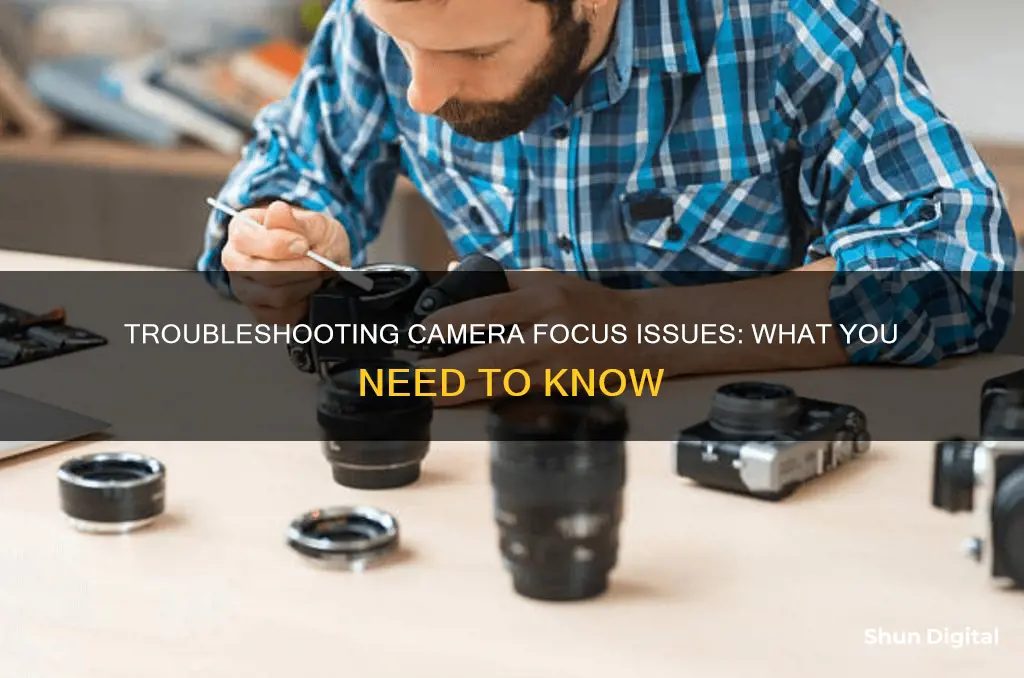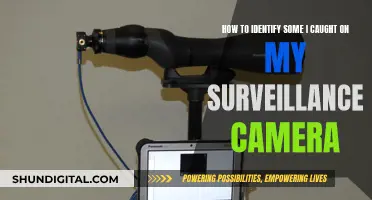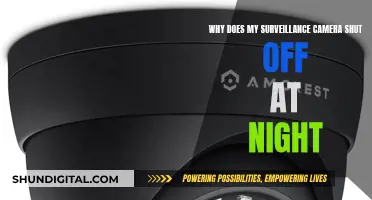
There are many reasons why a camera won't focus. For iPhone cameras, common issues include software glitches, damaged sensors, improper magnetic lens attachments, and wrong settings. For DSLR cameras, autofocus may not work in low-light conditions, when photographing non-contrasting subjects, or when focusing on repetitive patterns or moving objects.
| Characteristics | Values |
|---|---|
| Camera type | iPhone, DSLR |
| Camera model | iPhone 12, iPhone 12 Mini, iPhone 14 Pro, Canon EOS 1200D |
| Camera lens | Standard 18-55mm lens, ultra wide lens (0.5x zoom out) |
| Camera settings | Auto focus (AF), manual focus (MF), Macro Mode |
| Camera app features | Auto Focus and Auto Exposure Lock (AE/AF Lock) |
| Camera issues | Focusing and unfocusing, blurry photos, physical damage, autofocus mechanism not working, camera attachments, low light conditions, extreme contrasts, hardware issues |
What You'll Learn

Camera lens is dirty, damaged or has debris on it
If your camera lens is dirty, damaged, or has debris on it, it can affect the resulting image in several ways. Firstly, if there is dust, dirt, or debris on the lens, it can cause dark spots in your photos, especially if the particles are large enough to obstruct the light path. In some cases, you may notice light scratches on the lens surface, which can create flaws in your images. While minor surface scratches may not significantly impact image quality, deep scratches can cause noticeable issues. Additionally, if your lens has been exposed to sand, even a tiny amount can cause severe damage to the lens's inner elements, affecting camera settings and focus.
Another issue that can arise is fungus growth inside the lens. This typically occurs if the lens has been left in a humid environment or stored improperly after getting wet. Fuzzy black spots that resemble bugs or spiders indicate the presence of fungus. Unfortunately, by the time you notice the fungus, the fungal acid may have already caused permanent damage to the lens, and cleaning it may not resolve the issue.
Oil damage to the aperture blades can also impact your images. Oil can cause friction, slowing down the closing action of the aperture and resulting in overexposed photos. Sun damage can cause a similar issue, as the grease from the focus gears can liquefy and affect the aperture.
To prevent these issues, it is important to keep your camera lens clean and protected. Regularly blow off any dirt or dust, and use a lens cleaner and cloth to remove smudges or dirt. Additionally, consider taking your camera for a professional cleaning annually to maintain optimal performance.
Leica's Golden Cameras: A Limited Edition Run
You may want to see also

Camera settings are incorrect
Camera settings are a common reason why your camera won't focus. It's easy to forget to change your settings back to autofocus after using manual focus, so always check that your lens is set to autofocus mode. If you're shooting in low light, your autofocus may struggle, so you might need to adjust your ISO settings.
If you're shooting with a shallow depth of field, your autofocus may struggle to lock onto your subject. In this case, try increasing the depth of field in your settings by adjusting your aperture or focal length. If you're shooting a subject that's very close to the lens, you may also need to adjust your focus settings to a mode designed for close-up photography, often indicated by a flower icon.
Autofocus may also struggle with certain types of subjects. For example, if you're shooting a subject with very little contrast, like a cloudless blue sky, your autofocus may struggle to lock on. Similarly, repetitive patterns, like the windows on a skyscraper, can confuse autofocus systems. If you're shooting a subject with these characteristics, you may need to switch to manual focus.
It's always a good idea to check your camera settings before you start shooting, even if you think they're correct. It's easy to accidentally change a setting without realising, and this can ruin your photos.
Toucan Camera Battery Life: How Long Does It Last?
You may want to see also

Low light conditions
When shooting in low light, your camera may struggle to focus. Here are some tips to help you out in such situations:
Firstly, select the centre focus point. This is the most accurate and strongest option among the cross-type AF points. It can find contrast in two directions, not just one, making it more reliable in low light.
Secondly, utilise your focus assist light if you have one. This is a feature on some cameras that aids the camera in gauging where to focus in low-light conditions.
Thirdly, look for areas with high contrast. Whether you are shooting in low light or not, areas with high contrast will help you gain accurate focus. Cameras can track focus more effectively in higher-contrast areas.
Additionally, avoid using Servo modes in low light. In Servo modes, the camera is allowed to track the focus, but when paired with low-light situations, there will be fewer areas of high contrast, which may cause your camera and lens to struggle with focusing. Instead, find your point of focus manually.
Finally, consider using a lens with a larger maximum aperture, such as a 50mm f/1.8 or 35mm f/1.8. A larger maximum aperture will let in more light, allowing your camera to see better and focus more easily in low-light conditions.
Credit Score Concerns: Camera Tickets' Impact Explained
You may want to see also

Non-contrasting subjects
If your camera won't focus, it could be because your subject has no contrasting features. For example, a cloudless blue sky or a wall with a solid colour. In such cases, autofocus may struggle to lock on to the subject.
Your camera lens tries to use contrast areas of the photo to help focus on your subject. When the focus points of your lens are aiming at an area that is smooth and lacks contrast, you may encounter issues.
To solve this problem, you can try aiming your focus point at a spot with more contrast that's at a similar distance from your camera. Press the shutter button halfway down to focus, then re-aim your camera to compose your photo, then push the shutter the rest of the way down to get the shot.
Try focusing on the edge of your subject, or a bright spot, or their eyes if it's a person or animal—anything that has an edge or a contrasty area between light and dark.
The Kodak Camera: A Revolutionary Snapshot of History
You may want to see also

Phone case or camera attachments are not installed properly
If your phone case or camera attachments are not installed properly, it can cause issues with the camera's focus. This is because a misaligned case or attachment can partially block the camera lens or flash, leading to malfunctioning.
To resolve this issue, it is recommended to remove the phone case and any lens protectors or attachments. Once removed, try taking a photo to see if the camera can focus properly. If the camera focuses without the case and attachments, it is likely that they were not installed correctly and were interfering with the camera's operation.
When installing a phone case, ensure that it fits your phone model properly and does not obstruct the camera lens or flash in any way. For lens protectors or magnetic lens attachments, check that they are compatible with your phone model and are installed according to the manufacturer's instructions. Improperly installed or incompatible attachments can cause issues with the iPhone's optical stabilisation, resulting in focus problems.
In some cases, it may be necessary to try different cases or attachments to find ones that fit your phone correctly and do not interfere with the camera's functionality. It is also important to keep the camera lens clean, as dirt or debris can also affect the autofocus mechanism.
Where Does Your Device Store Camera Raw Presets?
You may want to see also







